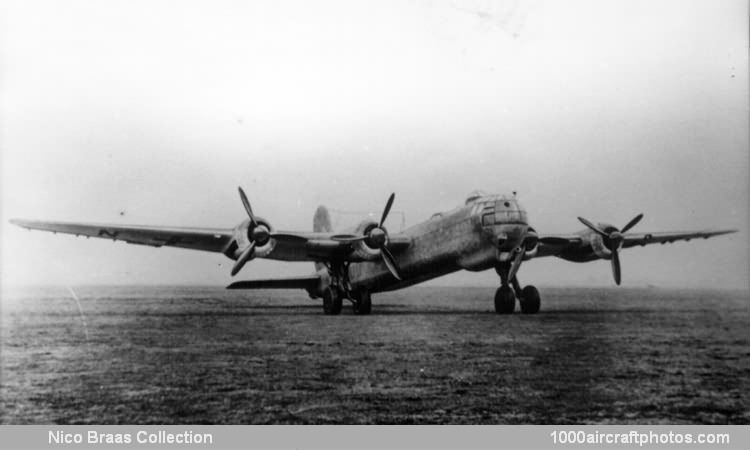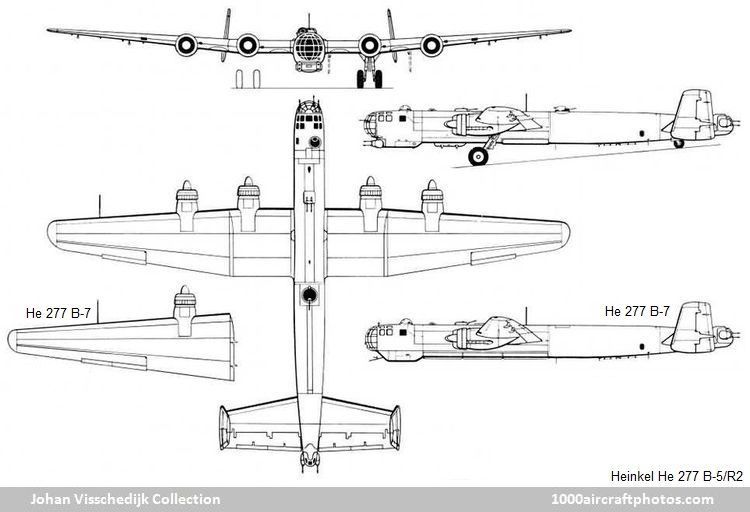01/31/2013. Remarks by Johan Visschedijk: "One of the simplest means of solving the power plant difficulties suffered by the He 177 would have been the adoption of four independent engines at a relatively early stage in the development life of the bomber, and Heinkel's project office at Vienna-Schwechat, Austria did, in fact, make such proposals to the RLM's Technische Amt in 1940. At that time, however, only the first prototypes were flying, and the RLM could not conceive the possibility that the initial difficulties encountered by the coupled engine arrangement might prove insurmountable. Furthermore, the use of four separate power plants had obvious disadvantages from the aerodynamic viewpoint, markedly increasing drag and resulting in inferior powers of maneuver.
By the autumn of 1941, the tendency on the part of the coupled engines to ignite was becoming increasingly serious, but while the Technische Amt agreed to a switch from coupled engines to four individual power plants for the He 274 pressurized high-altitude bomber as this embodied so much redesign that it no longer possessed any real commonality with the He 177 from which it stemmed, it was adamant in its refusal to countenance the development of the parallel He 277 which made use of standard He 177 airframe components and individual engines. Indeed, continued difficulties with the coupled engines and consequent pressure on the part of Professor Heinkel for the development of this bomber in favor of the He 177 resulted in Hermann Göring expressly forbidding any further mention of the He 277!
Despite this official opposition, Heinkel clandestinely continued the design development of the He 277, and in all correspondence its continued existence was disguised under the spurious designation He 177B, although all drawings, calculations and works memoranda still referred to the bomber as the He 277, so its unofficial development was very much an open secret, but it was not until May 1943 that official sanction for the development of this aircraft was obtained.
This came about as a result of a meeting held at Obersalzberg on the 23rd of that month between Adolf Hitler and senior representatives of the aircraft industry. During the course of the meeting, the Führer demanded a dual-purpose bomber capable of attacking London by day and night from altitudes at which interceptors would be powerless to intervene, and also suitable for attacking Allied convoys far out in the Atlantic. Heinkel claimed that the He 177B would be capable of fulfilling these demands, and was promptly given instructions to proceed immediately with its development.
A standard He 177A-3/R2 airframe was taken from the assembly line and modified to take four independent Daimler-Benz DB 603A twelve-cylinder liquid-cooled engines with annular nose radiators. Designated He 277 V1, the prototype began flight trials at Vienna-Schwechat late in 1943, and to delude Göring and the RLM, which was still opposed to any development that might detract from Heinkel's efforts in solving the production bomber's difficulties, the aircraft was referred to as the He 177 B-0.
The second prototype, the He 277 V2 (coded "GA+QQ"), referred to in correspondence between Heinkel and the RLM as the He 177 B-5/R1, was a conversion of a standard He 177 A-5/R8 airframe, and was flown for the first time on February 28, 1944. This aircraft was initially used primarily for stability trials, small auxiliary fins being added to the tail plane to rectify some directional instability, and in April was ferried to the E-stelle Rechlin for official evaluation.
The He 277 V3 (coded "KW+TT") was similar to the V2 when initially flown but some vestiges of directional instability remained, and these were finally eradicated by the introduction of an entirely new tail assembly employing twin fins and rudders. Like its immediate predecessor, the V3 was equipped with a defensive armament comprising a remotely-controlled Rheinmetall-Borsig "chin" barbette housing a battery of four 0.311 in (7.9 mm) MG 81 machine guns, a similar armament in a manned tail turret, a single MG 81 in the glazed nose, a pair of 0.511 in (13 mm) MG 131 machine guns in the remotely-controlled forward dorsal barbette, and a single MG 131 in the rear dorsal turret.
After a conference held on May 25, 1944, Göring, declaring that the heavy bomber remained "the kernel of aerial armament", ordered the immediate quantity production of the He 277 B, the aim being a delivery rate of no fewer than 200 machines per month!
The initial production model was the He 277 B-5/R2 intended for heavy bomber operation over medium and long-ranges and powered by four 1,750 hp DB 603A engines, but at that stage of the conflict Göring's order was anything but realistic, and on July 3, 1944, the entire bomber program was abandoned in favor of the "emergency fighter program" and only eight production He 277s were completed of which two or three were flown before all completed aircraft and those still on the assembly line were scrapped.
Prior to the termination of all bomber development, the He 277 B-7 long-range reconnaissance model was built, derived from the He 177 A-7 and featuring extended outer wing panels increasing overall span. Intended to take Jumo 213A, 213E or 222 engines with equal facility, only one example was actually completed and this with DB 603A engines. The sole He 277 B-7 was destroyed shortly before the arrival of Soviet troops."

